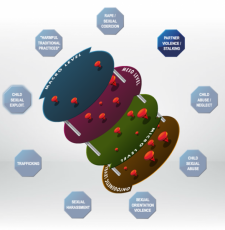Interactive, visual model on the use of violence available online
Thu 31 Jul 2014
An interactive model for understanding factors relevant to the perpetration of violence against women, violence against children and sexual orientation ...

An interactive model for understanding factors relevant to the perpetration of violence against women, violence against children and sexual orientation violence is freely available online.
The model of factors at play in the perpetration of violence seeks to make current research knowledge about factors that influence the use of violence more accessible to people in policy and practice. It also seeks to stimulate thinking about what might be done to reduce or prevent violence.
The visual, interactive model presents multiple levels in images, and patterns across types of violence and factors. The factors are located on four levels, depending on where their major impact appears: Macro (society), Meso (institutions, agencies, social environments), micro (face-to-face social groups), and ontogenetic (individual life history).
The authors emphasise that single factor explanations for the use of violence have been shown to be inadequate (although they continue to dominate everyday thinking): "There is a consensus across research and theory that interpersonal violence is multi-factorial and arises through the confluence of interacting influences at different levels." Accordingly, the factors it presents are not causal explanations for violence, but rather a probability model: it asks, what makes it more likely that individuals will use certain forms of violence?
'Path models' are also available, which shows the confluence of factors across all four levels. They display information about how factors may interact – again, they are not a causal chain of determination.
The model was developed for the European Commission, based on a research review which is also available.
Read the introduction and manual first for an understanding and explanation of the model.
Image: European Commission


